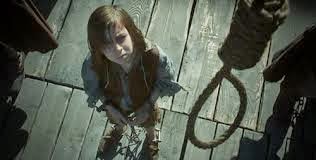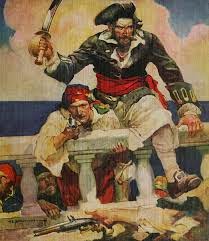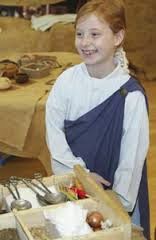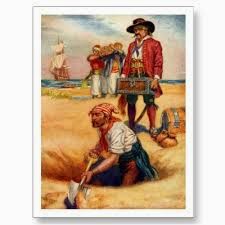We all know that pirates were law-breakers. That’s
kind of a definition of the job. But what were the laws, anyway? What was the
British legal system like in 1715?
The beginning of this answer is: A lot different
than it is today.
British law was undergoing a rather radical change
at the time, from a medieval system primarily designed to punish people who
stepped outside the system, to a system designed to deter crimes against
property.
This change was driven by the rise in what we would call
the upper middle class. Unlike previous people with money, their wealth was not
tied up in land, but in property such as homes, carriages, artwork and fine
clothing. These people wanted to protect their possessions, and also their business
dealings.
Because of this, England set out on a course of new
laws designed to deter undesirable behavior. Crimes like shoplifting, robbing a
house or rioting were punishable by death. The list of crimes that fell under
this category grew by leaps and bounds, from about 26 during the Golden Age or Piracy to well over two hundred by
the mid 1700’s.
The laws of the time are today referred to as “The
Bloody Code” though they were never called this while they were in force.
The goal – to paraphrase a quote from the time –
was not to punish the stealing of horses but to prevent the stealing of horses.
Today we wouldn’t understand many of the distinctions
in these laws. For instance, it was legal for a nobleman to rape a common woman,
on the theory that she would necessarily be so flattered at the possibility of
bearing a noble child that she was not capable of resisting.
A commoner raping a noblewoman, however, was a crime
against the woman’s family.
It was perfectly legal to beat a person nearly to
death, so long as they were not permanently disabled or killed. But it was
illegal to damage their clothing by cutting it, as this was property damage.
Women were not legally allowed to own property. Counterfeiting was illegal for
both men and women, but men were hanged for the crime, while women were burned
alive. These are only a few examples,
but you get the drift.
Similarly, the court proceedings would not be
recognized by modern folks, especially Americans. The job that Americans refer
to as “lawyer” was divided between a solicitor (who represented the client in
court) and a barrister (who was hired by the client and researched the law).
People who were arrested did not get out on bail.
They were kept in chains and locked up in prison, where they were kept pending
trial. If they did not have much money, or friends outside to help them, they
did not receive food or drink above the bare necessities for survival. They
slept on the floor in piles of straw, and were not provided a change of
clothing, or even wash water. Trial could be expected to come within a few
weeks, but the accused would be filthy, bedraggled and much thinner when
standing before the judge. It would be easy to convict such a person.
Nor were the accused given any information about the
case or their legal rights, unless they or some friend could afford to hire
legal representation. This put the poor at a severe disadvantage. But the laws
were written specifically for the rich, anyway. God, it was believed, had
already decided that the rich were better and more important people than the
poor. That was why they were rich. God had blessed them.
Bringing a court case was more difficult for a
poor person as well. The burden of proving the case was entirely on them. There
were no police departments yet. Instead, men similar to private detectives could
be hired – for a price – to investigate, gather evidence and bring the accused
to be locked up. These men were called thief-takers. Though their fees were not
prohibitive to the well-to-do, they could destroy a poor family.
Thief-takers were also very prone to corruption.
Since they were paid to gather evidence, they could accuse an innocent person
and be believed. This in turn could lead to blackmail, protection rackets and perjury.
The system was ripe for abuse.
Even bringing a case to court was expensive. The
person bringing the case needed to pay the court costs up front, and this kind
of money was out of the reach of the poor. If a rich person cheated on a
contract or took the property of a poor person, it would be almost impossible
for the poor person to raise enough money to hire legal help, have papers
served, and pay the necessary court costs. The rich were safe.
Punishments, besides hanging, were also not what
modern people would expect. Instead, the system looked more like something one
could imagine in a radical Islamist state. People could be burned at the stake,
hanged, or skinned and cut into pieces. For less severe crimes, the punishment
might be lashes with a whip, strokes with a rod, or even being tied to the back
side of a cart and dragged through town while being beaten by a gang of men
with various instruments. Simply being locked up was not an option.
Even “the stocks”, that cute little punishment
that we today associate with the Puritans, was much more harsh than it seems. Yes,
the punishment was to be confined by having the head and hands, or maybe the head
hands and feet, immobilized by a wooden device. What we don’t think of was
that, while confined, the person could have rocks thrown at them, or rotten
fruit, or dead animals. Hot oil could be poured on them. In fact, any abuse
that an angry or bored populace could dish out was okay.
Once again, the rich got off easier. Their
families could afford to hire body guards for the event.
Oh, and piracy? The date when piracy became
illegal is not clear, but was a death-penalty crime since long before the
Golden Age. Piracy broke both the old laws (being outside the social structure)
and the new ones (stealing and destroying property, and committing murder).
Hanging was the penalty, but further rituals grew up around the ritual of punishing pirates. In England, it was
traditional to hang a pirate at low tide, then bind the dead body to a pole and
let 3 tides wash over it. After this, the body would either be given to a
medical school for dissection or covered in tar, bound with iron bands and hung
up as a warning to others.
Piracy was one of the last death penalties still
on England’s law books. The death penalty for piracy, along with high treason,
was reduced to life imprisonment in 1998.







































